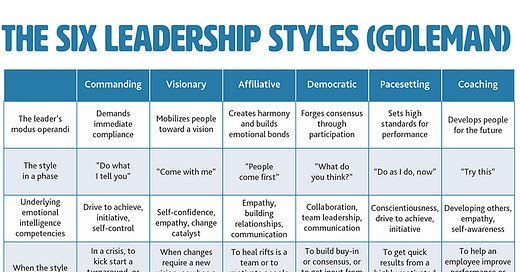Everyone leads at some point in their life—whether it's leading a meeting, a project, a team, or a company. Effective leadership means having the ability to inspire, influence, and achieve goals with others and oneself.
Understanding your leadership style helps you lead effectively, identify areas for development, and stay aligned with your values. You might not know exactly what kind of leader you are, but by exploring different leadership styles and understanding your strengths and values (i.e. (the type of person you want to be), you can start developing and leveraging new styles as needed.
My own leadership has evolved over the years, from being the captain of my class in elementary school to managing teams and cultivating new leaders. This journey required a lot of self-work, deliberate learning, and support from my personal board of directors.
Knowing yourself and understanding which leadership styles are most appropriate for different situations can help you inspire, influence, and achieve goals effectively.
Type of Leadership Styles
Here are some common leadership styles I’ve summarized (as well as another version first categorized by Daniel Goleman, attached below):
Autocratic: Decisions are made with little input from team members. Strong control and directives.
Coaching: Focused on developing individuals. Strong psychological safety.
Democratic: Decisions are made with team members involved. Highly collaborative.
Laissez-faire: Decisions are made by team members with minimal supervision. High autonomy.
Servant: Focused on empowering individuals and teams. Uplifting environment.
Transactional: Focused on rewards and punishments. Strong process and structure.
Transformational: Focused on inspiring team members to act. Highly visionary.
Situational: Flexible styles based on the context and environment. Highly adaptive.
Striving towards a Situational Leader
Personally, I aspire to leverage and practice situational leadership, also known as the Hersey-Blanchard model. It’s my go-to framework for determining the best way to support others in both professional and personal situations. Going through the Situational Leadership training by The Center for Leadership Studies 8 years ago helped me acquire the vocabulary and framework to develop my own style since.
Telling
Low competence & low confidence. Lots of hand-holding and specific directives are needed.
Professional Example: When growing an analytics team, I provided clear, step-by-step instructions to new members until they felt comfortable and competent.
Personal Example: When introducing friends to indoor bouldering, I demonstrated techniques and provided close supervision and encouragement.
Selling
Mid competence & high confidence. Some directives but more focus on enticing the individual with bigger picture.
Professional Example: When I was managing a team of analysts, I connected a confident analyst with SMEs to deepen their understanding of email system design, explaining the significance of various data labels and how all combined could impact the business positively.
Personal Example: I convinced my hesitant dad to join a family trip to Japan by highlighting the fun and quality time we’d spend together.
Participating
High competence & medium to low confidence. Share decision making responsibilities and give less directives.
Professional Example as a People Manager: I involved an analyst in decision-making for a major data modeling project, providing support while they took ownership of the development and implementation.
Professional Example as a Coach: As a coach, I helped clients pivoting to new careers by brainstorming together and directly challenging them how to apply their existing skills creatively.
Delegating
High competency & high confidence. Delegate fully and only check in on progress periodically.
Professional Example: I trusted a lead analyst to handle new marketing projects independently, checking in periodically.
Personal Example: I entrusted my partner, a wine expert, to select the wedding drink menu, only checking in occasionally.

Leadership is both an art and a science. It took me years to learn and practice these styles, and I’m still learning! What leadership styles do you naturally excel at or aspire to develop?
Stay tuned for future series on choosing the best leadership style for you and developing your leadership skills.
Curious how to find your own leadership style?




